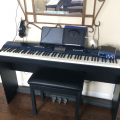Loopy Pro: Create music, your way.
What is Loopy Pro? — Loopy Pro is a powerful, flexible, and intuitive live looper, sampler, clip launcher and DAW for iPhone and iPad. At its core, it allows you to record and layer sounds in real-time to create complex musical arrangements. But it doesn’t stop there—Loopy Pro offers advanced tools to customize your workflow, build dynamic performance setups, and create a seamless connection between instruments, effects, and external gear.
Use it for live looping, sequencing, arranging, mixing, and much more. Whether you're a live performer, a producer, or just experimenting with sound, Loopy Pro helps you take control of your creative process.
Download on the App StoreLoopy Pro is your all-in-one musical toolkit. Try it for free today.
Sean Costello teaches how to code a Reverb
I bought Desktop ValhallahDSP reverb on the recommendation of @jonmoore and became aware of Sean Costello's creativity with Reverb coding. His DSP code is used in the IOS EOS 2 Reverb.
He has decided to blog his advice to anyone interested in understanding the options available to code a reverb. Of course, the advice can be generically applied to music app development.
TL;DR - use the Juce framework and for DSP code use C++.
https://valhalladsp.com/2021/09/20/getting-started-with-reverb-design-part-1-dev-environments/



Comments
For those that don’t already know, his most recent free plugin Supermassive is sooo good.
https://valhalladsp.com/shop/reverb/valhalla-supermassive/
Freqecho also free and really cool
https://valhalladsp.com/shop/delay/valhalla-freq-echo/
Amazing dev to support on desktop
Get all Valhalla plugins. The delay is insane. Vintage Verb is epic and Supermassive is divine.
Sean Costello is a master of his art and sells his plugins at a very reasonable $50 a piece (which for the quality, is insanely low for desktop plugins). But his three free plugins are just as essential as the ones he charges for. If you start with the free ones alone, your creative FX arsenal will be provided with a booster shot of real worth.
Article #2 in online:
https://valhalladsp.com/2021/09/22/getting-started-with-reverb-design-part-2-the-foundations/
It recommends a list of academic papers on acoustics covering decades of research.
They were talking about "colorless reverbs" in the 1970's. I'm curious to see when the
papers switch from analog to digital designs.